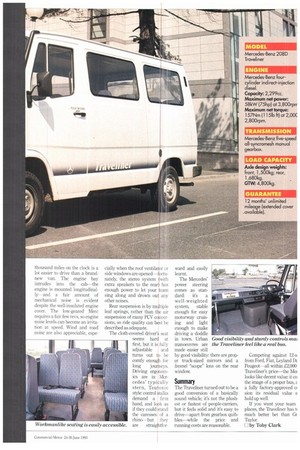S o you run a football team, and you need to
Page 16

Page 17

If you've noticed an error in this article please click here to report it so we can fix it.
get it from place to place? An ample coat pocket should suffice for a Subbuteo squad, but if your players are the full-size variety you could do with something like the Mercedes Traveliner. A 12-passenger minibus that can be driven without benefit of PCV licence, the Traveliner appears in Mercedes' price list as a standard model.
Why are we testing a bus? Well, in a depressed market manufacturers cannot afford to stick to their bread-and-butter models: they have to offer "added value" by producing vehicles tailored exactly to each customer, and they need to be sure of the quality of third-party conversions —hence the growing length of options lists and the proliferation of recommended bodybuilders and converters.
Minibus conversions are a good test of the relationship between manufacturer and converter: PCV operators have specialised needs, quite different from those of the van market, so comprehensive modifications have to be made at minimal cost and with safety legislation strongly in mind.
The Mercedes Traveliner is based on the 2081) van, assembled in the UK by Devon Conversions. Devon is well known for its minibuses and motor-caravans—including current models based on the Fiat Ducat°, Volkswagen LT and heavier Mercedes models—but this is a departure in that they are converting the van according to Mercedes-Benz' own design. The Traveliner was introduced at the beginning of the year, and is on target for annual sales of 100 vehicles.
Productivity
The Traveliner will accommodate a football team, but only of the Association variety: with just twelve passenger seats, if you favour the Union game you're out of luck—still, a Rugby League side could take turns driving. However, the minibus has a kerbweight of 1,905kg, leaving a maximum payload (including the driver) of 895kg. Divide this by thirteen, and each occupant can tip the scales at 68.8kg: about ten stone twelve. So much for beefy footy players— the half-time oranges might have to be left at home. In any case, the seats are pretty narrow (to accommodate three per row plus an aisle) so porky passengers need not apply.
Access to the seating is good, however, with a low entrance step and the absence of a seat beside the driver; it gives the Traveliner the air of a "real" bus, and the driver the urge to ask for exact change only.
Over our testing Kent van route, the unladen Mercedes was reasonably frugal, consuming dery at the rate of 9.5 lit/100km (29.7mpg) and managing a respectable average speed of 70.0km/h (41.6mph)—with a full complement of passengers one could expect fuel consumption to rise by 10% or so.
On the road
The first impression of driving the Traveliner is the extreme effort needed to get into first gear: the engine isn't big enough for steamroller-type torque, so frequent gearchanges are a fact of life in town and the stiff, notchy gearbox soon becomes a pain in the arm. Fortunately this trait—common among Mercedes' vans—lessens as the engine and gearbox warm up, and it should disappear as the miles rack up: a T1 with ten thousand miles on the clock is a lot easier to drive than a brandnew van. The engine bay intrudes into the cab—the engine is mounted longitudinally and a fair amount of mechanical noise is evident despite the well-insulated engine cover. The low-geared Mere requires a fair few revs, so engine noise levels can become an irritation at speed. Wind and road noise are also appreciable, espe
daily when the roof ventilator or side windows are opened fortunately, the stereo system (with extra speakers to the rear) has enough power to let your team sing along and drown out any other noises.
Rear suspension is by multiple leaf springs, rather than the air suspension of many PCV conversions, so ride quality can best lie described as adequate.
The cloth-covered driver's seat seems hard at first, but it is fully adjustable and turns out to be comfy enough for
long journeys. Driving ergonomics are in Mercedes' typically stern, 'feutonic style: control stalks demand a firm hand, and look as if they could star id the caresses of a rhino—but they are straightfor ward and easily learnt.
The Mercedes' power steering comes as standard: it's a well-weighted system, stable enough for easy motorway cruising and light enough to make driving a doddle in town. Urban manoeuvres are made easier still by good visibility: there are proper truck-sized mirrors and a fresnel "scope" lens on the rear window.
SUMMary The Traveliner turned out to be a good conversion of a basically sound vehicle; it's not the plushest or fastest of people-carriers, but it feels solid and it's easy to drive—apart from gearbox quibbles—while the price and running costs are reasonable. Competing against 12-s from Ford, Fiat, Leyland Ek Peugeot—all within £2,000 Traveliner's price—the Mei looks like decent value: it co the image of a proper bus, a fully factory-approved cc sion its residual value s hold up well.
If you want your team places, the Traveliner has ti much better bet than Gr Taylor.
El by Toby Clark
















































































